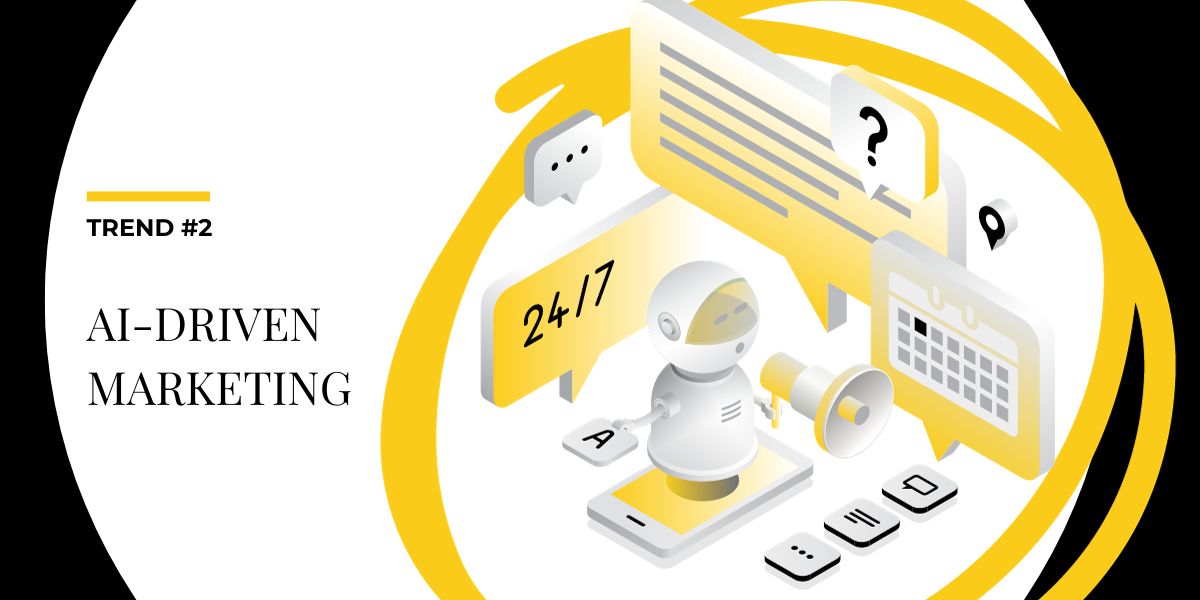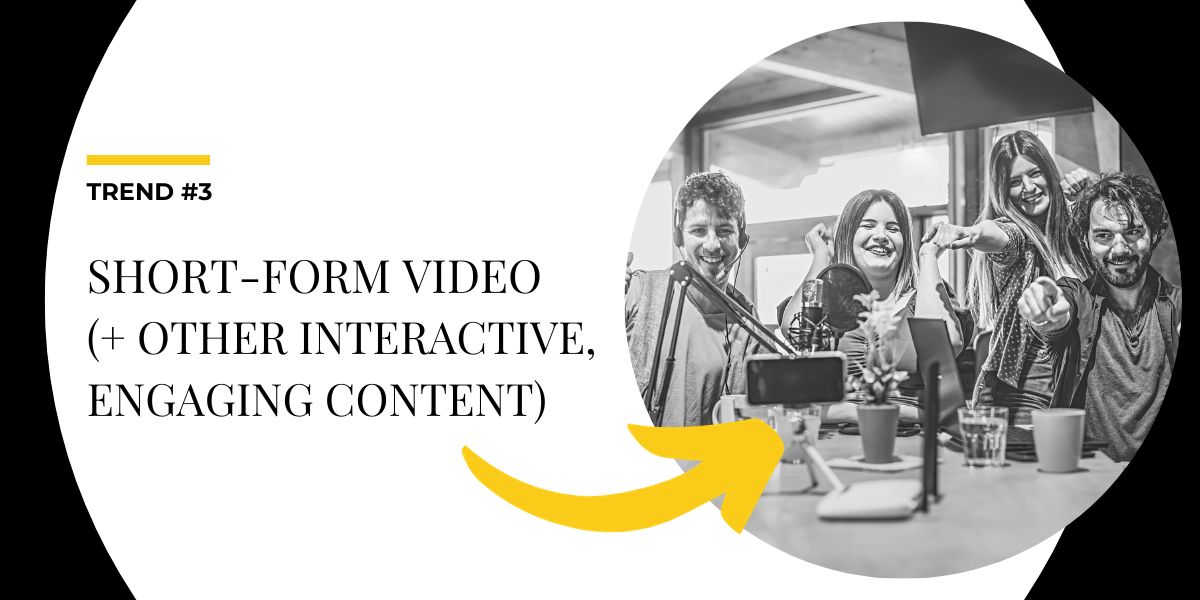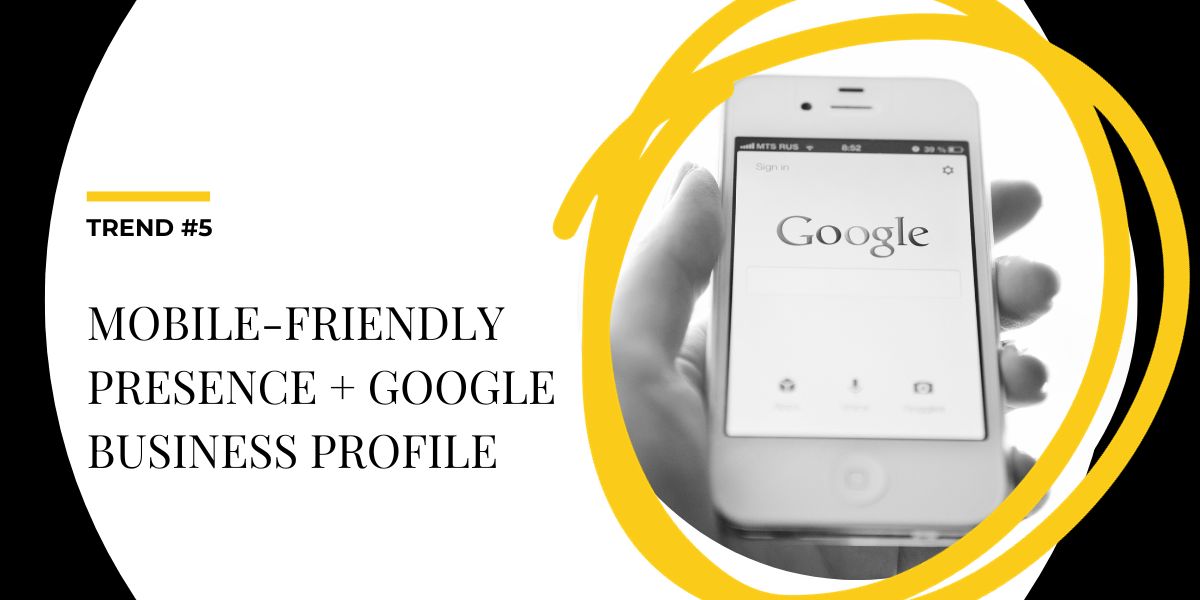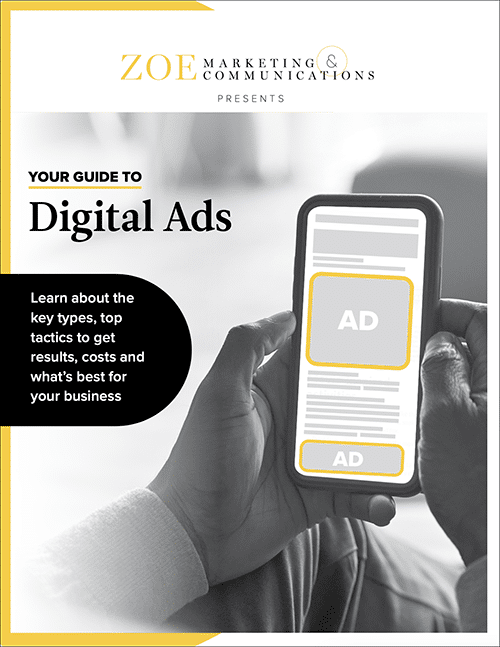What were you worried about in November 2022? Probably not artificial intelligence. But then, in December, ChatGPT changed marketing dramatically.
Now, looking ahead to 2024 marketing trends, AI keeps evolving — while attention spans shrink and brand scrutiny rises.
Feeling overwhelmed? You’re not alone. At Zoe Marketing & Communications, we track these shifts closely for our clients. And we’ve identified six can’t-ignore marketing trends for 2024:
We’ll break down what each means, the risks of ignoring them, and practical steps to adapt.
FREE GUIDE
Download Your Digital Ads Guide
Learn how digital ads can help your business, including the tools, techniques and strategies to create successful campaigns.
1. Voice search optimization

More people are talking to Google instead of typing. 71% prefer voice search, OnlineDasher notes, and 55% use it to find businesses.
Risk of ignoring it: Losing a growing demographic
- Voice search isn’t just for Gen Z anymore. It’s expanding across age groups.
- If your product descriptions don’t trigger Alexa results, you’re missing potential customers.
- Voice search prioritizes one single result. If you’re not optimized, you’re invisible.
Solutions: Conversational content + schema markup
- Use natural, long-tail keyword: Example: Instead of “urgent care Ferndale,” try “Where is an urgent care in Ferndale?”
Implement schema markup: Google’s Structured Data Markup Helper improves rich snippet visibility.
2. AI-driven marketing

AI is streamlining content, social media, ads and data analysis, saving time and boosting efficiency.
Risk of ignoring it: Falling behind competitors
- Wasted resources: Manual marketing lacks the precision AI brings.
- Missed insights: AI analyzes trends in real-time, helping optimize faster.
Solutions: Choose AI tools, train them and track data
- Content creation: Use AI writing tools (ChatGPT, Copy.ai, etc.) to draft content, but always edit for brand alignment.
- Social media: Automate scheduling with tools like Hootsuite or Buffer.
- Data tracking: Leverage AI-powered Google Analytics and HubSpot for deep audience insights.
3. Short-form video + other engaging content

Marketing is shifting away from static, text-heavy content. People expect engaging, fast, visual content like short videos, infographics and quizzes.
Risk of ignoring it: Losing audience attention
- The average attention span is 8 seconds.
- Static content struggles to compete with videos and interactive elements.
Solutions: Short videos, infographics, quizzes, and repurposing
- Create short-form videos (30-60 seconds) for Meta reels, TikTok and YouTube Shorts.
- Design infographics to simplify complex info (use Canva or Piktochart).
- Make quizzes that engage users (e.g., “Which fitness plan suits you best?”).
- Repurpose content. Turn a blog post into a video or infographic.
4. Localization

If you serve a specific region, your marketing should reflect that in an obvious way.
Risk of ignoring it: Missing immediate consumer action
- Local searchers act fast. They need answers now.
- If you’re missing from local directories, regional keywords or Google Business Profile (GBP), you’re losing leads.
Solutions: Localized FAQs, geotargeting, and local SEO
- Answer local questions: Google autocompletes what people ask in your area.
- Geotarget ads and emails based on your region.
- Use local keywords: Google Keyword Planner and BrightLocal help identify top local search terms.
5. Mobile-friendly websites + Google Business Profiles

Your website experience and Google Business Profile listing directly impact conversions.
Risk of ignoring it: Poor first impressions = lost leads
- Over 55% of website traffic is mobile. A bad mobile experience increases bounce rates.
- An incomplete GBP listing loses potential walk-ins, calls, and purchases.
Solutions: Mobile optimization + GBP updates
- Ensure a responsive website (use Google’s Mobile-Friendly Test).
- Improve your GBP listing: Update hours, services, photos and reviews.
- Reply to reviews within 24 hours. A caring, professional response builds trust.
6. Hyper-personalization

People expect brands to know them. Personalization boosts sales, loyalty and engagement.
Risk of ignoring it: Low engagement and conversions
- 91% of consumers prefer brands that personalize their experience.
- Personalization increases click rates by 41% and sales by 20%.
Solutions: Analytics, tailored content, and programmatic ads
- Use Google Analytics and HubSpot to track customer behavior and adjust messaging.
- Personalize emails, blogs and ads based on browsing history.
- Run programmatic ads. AI analyzes user behavior in real time to deliver customized ads.
Next steps to tackle any digital marketing trends
Marketing is changing fast — but you don’t have to be overwhelmed. You now have straightforward steps to adapt to AI, voice search, short videos, localization, mobile optimization and personalization in 2024 and beyond
Want expert help? Talk to us at Zoe Marketing & Communications. We’ll build a custom strategy to make these trends work for you.
Still navigating digital marketing solo? These articles will help:
Kim Kovelle
As Zoe Marketing & Communications’ content manager, Kim Kovelle brings over 20 years of writing and editing experience in metro Detroit. She has strong roots in community journalism and a knack for making complicated topics make more sense.









